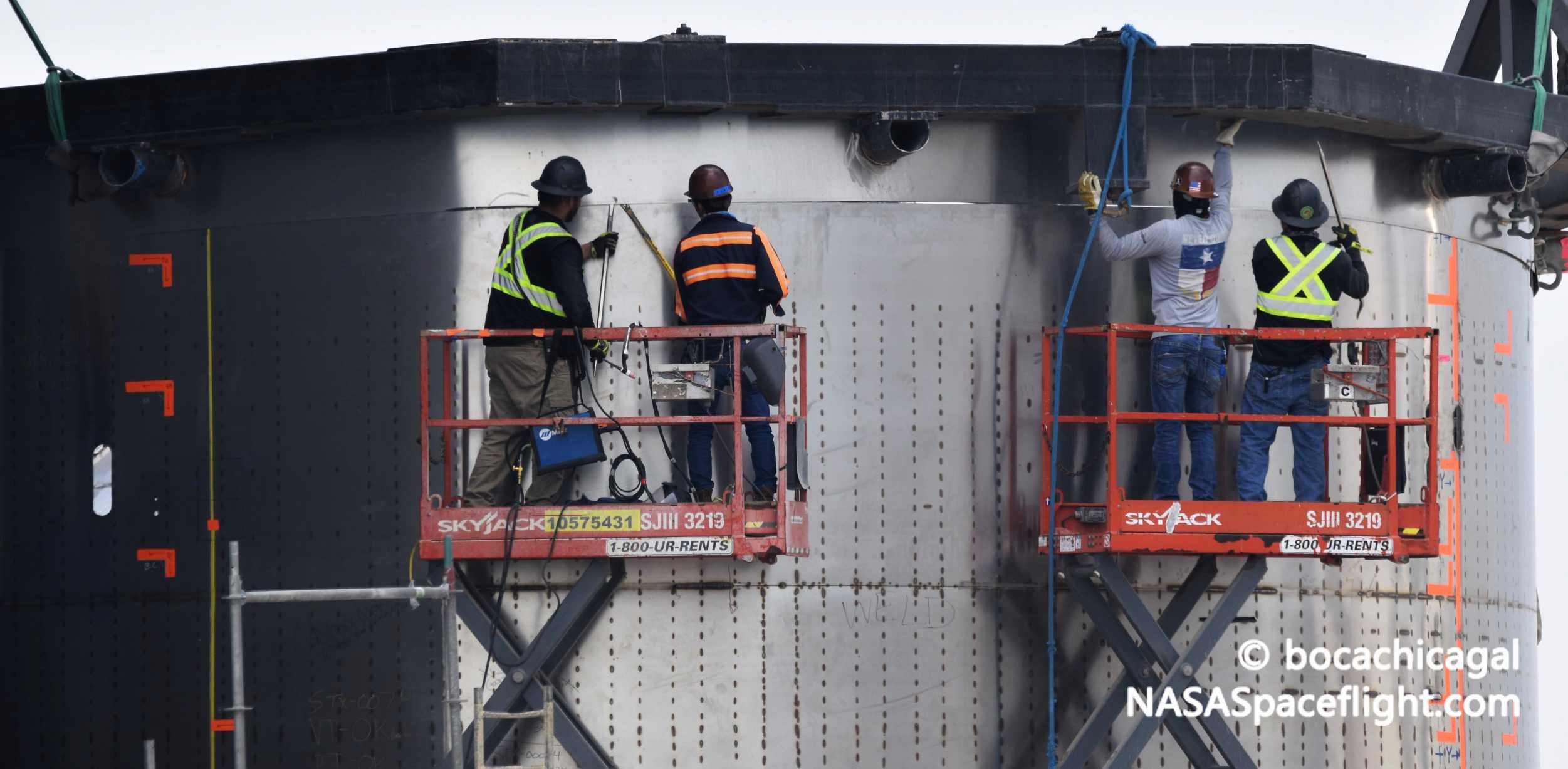
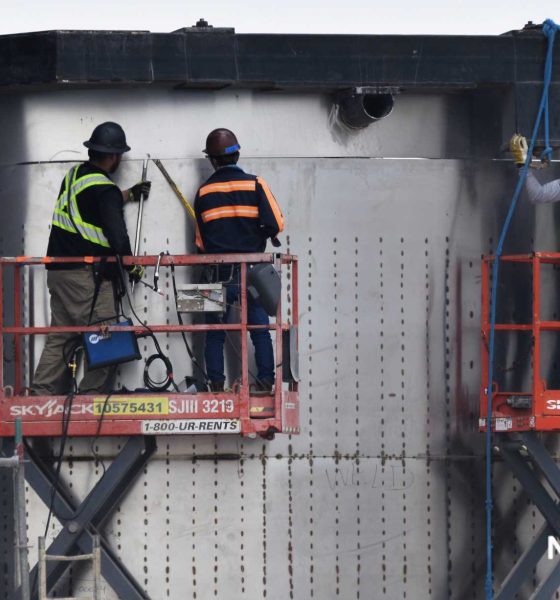
News
SpaceX’s next Starship prototype is already closing in on its first tests
Continuing a trend of massive steel rockets built in a matter of days and weeks instead of months, SpaceX’s next Starship prototype is already closing in on its first tests.
SpaceX’s newest vehicle is set to pick up where the third full-scale Starship prototype – coincidentally known as SN3 – left off after operator error lead to its premature destruction on April 3rd. Now a pile of scrap metal, that ship only made it partway through cryogenic proof testing when its upper tank – almost fully filled with chemically-neutral liquid nitrogen – toppled over and pulled the rest of the prototype with it. With (hopefully) improved test procedures, Starship SN4 is now set to carry that torch forward.
Following the late Starship SN1 and SN3 prototypes, SN4 is on track to be the third full-scale, functional Starship prototype built in a handful of weeks thanks to major factory upgrades SpaceX has completed in recent months. While the loss of any particular prototype is undoubtedly a setback each time it happens, such a high rate and (apparently) low cost of production means that no single failure should be a major disruption, allowing SpaceX to iterate incredibly quickly as it learns from a flurry of real-world tests.
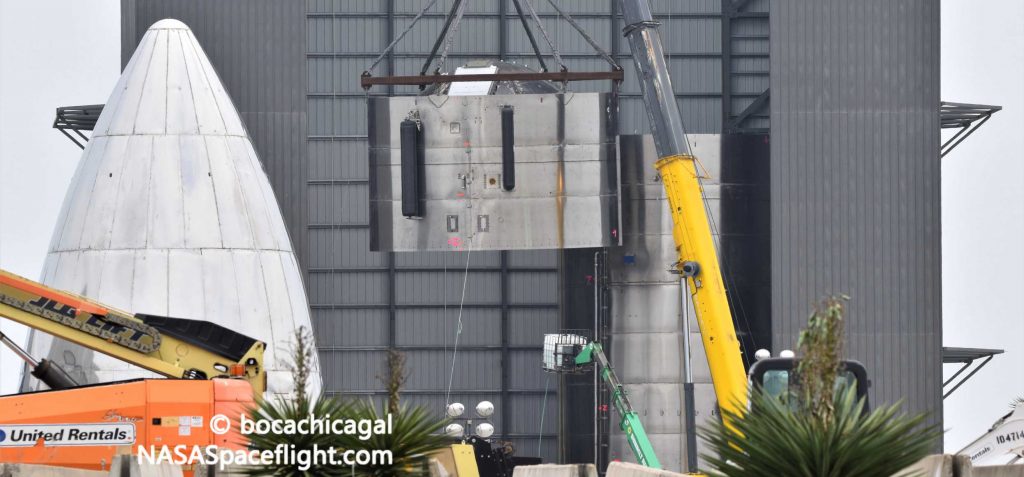
Like SN3, SpaceX’s next prototype will soon be fully stacked and transported down the road from the factory to a nearby launch and test facility, both situated directly on the South Texas Gulf Coast. Based on SN1 and SN3, SN4 could be just a week or so away from that transport milestone. SN3, for example, reached Starship SN4’s current state of assembly around March 20th. Eight days later, the vehicle was moved to the launch pad for its first tests.
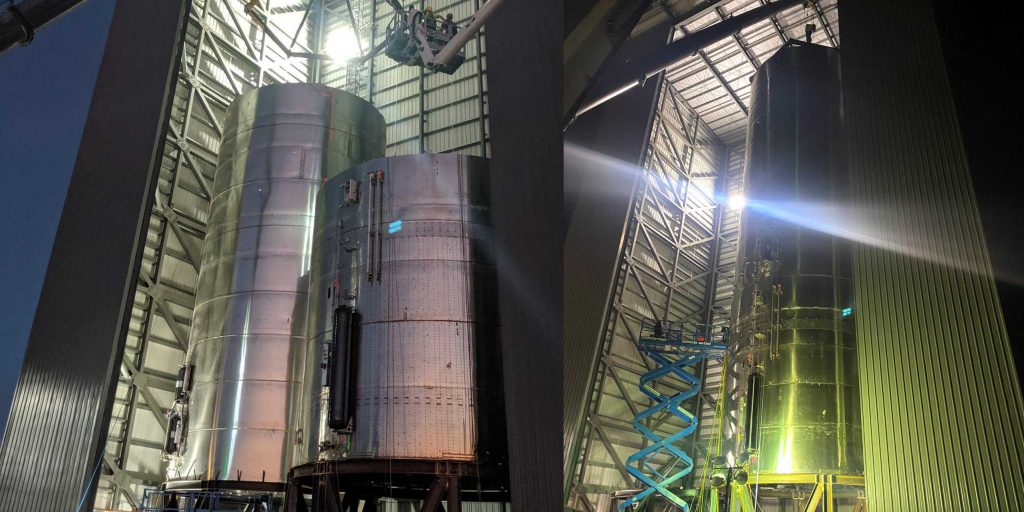
On April 12th, SpaceX technicians flipped Starship SN4’s aft-most section, doubling as a bottom dome of its liquid oxygen tank and a mounting point for three Raptor engines. Starship SN3 passed the same point around March 18th, just ten days before it was moved to the launch pad. Per SN3’s assembly schedule, it should be just 2-3 days before SpaceX wraps up Starship SN4’s engine section by adding another two rings, followed by the engine section’s integration with the rest of the rocket approximately 5-7 days from now.
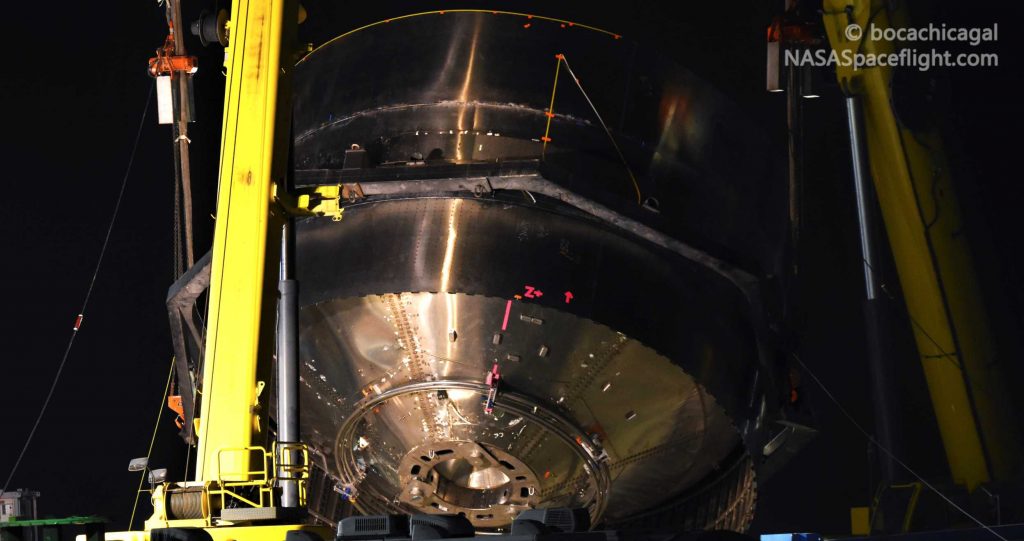
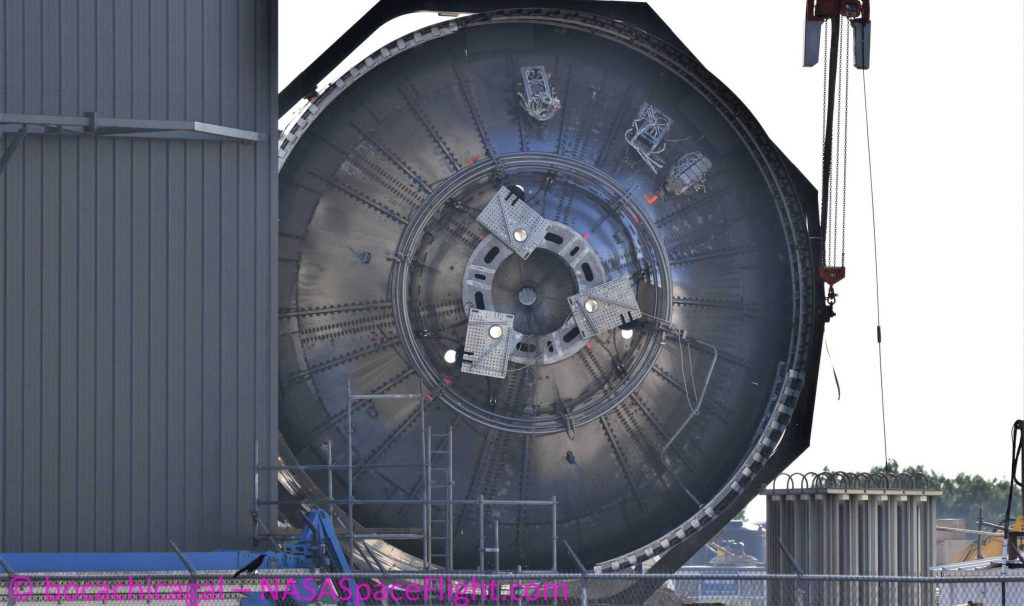
Based on Starship SN3’s behavior before a badly-designed test triggered the series of events that destroyed it, the ship appeared to be performing extremely well with its upper (methane) tank almost completely full of super-cool liquid nitrogen. If Starship SN4 does a similarly good job and makes it through the rest of the test that SN3 was unable to, SpaceX has three Raptors already tested and ready to go for their first triple-engine static fire ever.
At this point, those engines are simply waiting in a nearby hangar for a Starship prototype to be declared flight (or at least static fire) worthy. Even more excitingly, should both the engines and the Starship in question perform flawlessly during those tests, the first flights are expected to follow very soon after. Whether it’s able to summit that particular hurdle, Starship SN4’s current rate of production suggests that the ship will be ready to kick off testing later this month, perhaps less than three weeks after its predecessor kicked the bucket. Stay tuned!

News
Nvidia CEO Jensen Huang explains difference between Tesla FSD and Alpamayo
“Tesla’s FSD stack is completely world-class,” the Nvidia CEO said.

NVIDIA CEO Jensen Huang has offered high praise for Tesla’s Full Self-Driving (FSD) system during a Q&A at CES 2026, calling it “world-class” and “state-of-the-art” in design, training, and performance.
More importantly, he also shared some insights about the key differences between FSD and Nvidia’s recently announced Alpamayo system.
Jensen Huang’s praise for Tesla FSD
Nvidia made headlines at CES following its announcement of Alpamayo, which uses artificial intelligence to accelerate the development of autonomous driving solutions. Due to its focus on AI, many started speculating that Alpamayo would be a direct rival to FSD. This was somewhat addressed by Elon Musk, who predicted that “they will find that it’s easy to get to 99% and then super hard to solve the long tail of the distribution.”
During his Q&A, Nvidia CEO Jensen Huang was asked about the difference between FSD and Alpamayo. His response was extensive:
“Tesla’s FSD stack is completely world-class. They’ve been working on it for quite some time. It’s world-class not only in the number of miles it’s accumulated, but in the way it’s designed, the way they do training, data collection, curation, synthetic data generation, and all of their simulation technologies.
“Of course, the latest generation is end-to-end Full Self-Driving—meaning it’s one large model trained end to end. And so… Elon’s AD system is, in every way, 100% state-of-the-art. I’m really quite impressed by the technology. I have it, and I drive it in our house, and it works incredibly well,” the Nvidia CEO said.
Nvidia’s platform approach vs Tesla’s integration
Huang also stated that Nvidia’s Alpamayo system was built around a fundamentally different philosophy from Tesla’s. Rather than developing self-driving cars itself, Nvidia supplies the full autonomous technology stack for other companies to use.
“Nvidia doesn’t build self-driving cars. We build the full stack so others can,” Huang said, explaining that Nvidia provides separate systems for training, simulation, and in-vehicle computing, all supported by shared software.
He added that customers can adopt as much or as little of the platform as they need, noting that Nvidia works across the industry, including with Tesla on training systems and companies like Waymo, XPeng, and Nuro on vehicle computing.
“So our system is really quite pervasive because we’re a technology platform provider. That’s the primary difference. There’s no question in our mind that, of the billion cars on the road today, in another 10 years’ time, hundreds of millions of them will have great autonomous capability. This is likely one of the largest, fastest-growing technology industries over the next decade.”
He also emphasized Nvidia’s open approach, saying the company open-sources its models and helps partners train their own systems. “We’re not a self-driving car company. We’re enabling the autonomous industry,” Huang said.
Elon Musk
Elon Musk confirms xAI’s purchase of five 380 MW natural gas turbines
The deal, which was confirmed by Musk on X, highlights xAI’s effort to aggressively scale its operations.

xAI, Elon Musk’s artificial intelligence startup, has purchased five additional 380 MW natural gas turbines from South Korea’s Doosan Enerbility to power its growing supercomputer clusters.
The deal, which was confirmed by Musk on X, highlights xAI’s effort to aggressively scale its operations.
xAI’s turbine deal details
News of xAI’s new turbines was shared on social media platform X, with user @SemiAnalysis_ stating that the turbines were produced by South Korea’s Doosan Enerbility. As noted in an Asian Business Daily report, Doosan Enerbility announced last October that it signed a contract to supply two 380 MW gas turbines for a major U.S. tech company. Doosan later noted in December that it secured an order for three more 380 MW gas turbines.
As per the X user, the gas turbines would power an additional 600,000+ GB200 NVL72 equivalent size cluster. This should make xAI’s facilities among the largest in the world. In a reply, Elon Musk confirmed that xAI did purchase the turbines. “True,” Musk wrote in a post on X.
xAI’s ambitions
Recent reports have indicated that xAI closed an upsized $20 billion Series E funding round, exceeding the initial $15 billion target to fuel rapid infrastructure scaling and AI product development. The funding, as per the AI startup, “will accelerate our world-leading infrastructure buildout, enable the rapid development and deployment of transformative AI products.”
The company also teased the rollout of its upcoming frontier AI model. “Looking ahead, Grok 5 is currently in training, and we are focused on launching innovative new consumer and enterprise products that harness the power of Grok, Colossus, and 𝕏 to transform how we live, work, and play,” xAI wrote in a post on its website.
Elon Musk
Elon Musk’s xAI closes upsized $20B Series E funding round
xAI announced the investment round in a post on its official website.

xAI has closed an upsized $20 billion Series E funding round, exceeding the initial $15 billion target to fuel rapid infrastructure scaling and AI product development.
xAI announced the investment round in a post on its official website.
A $20 billion Series E round
As noted by the artificial intelligence startup in its post, the Series E funding round attracted a diverse group of investors, including Valor Equity Partners, Stepstone Group, Fidelity Management & Research Company, Qatar Investment Authority, MGX, and Baron Capital Group, among others.
Strategic partners NVIDIA and Cisco Investments also continued support for building the world’s largest GPU clusters.
As xAI stated, “This financing will accelerate our world-leading infrastructure buildout, enable the rapid development and deployment of transformative AI products reaching billions of users, and fuel groundbreaking research advancing xAI’s core mission: Understanding the Universe.”
xAI’s core mission
Th Series E funding builds on xAI’s previous rounds, powering Grok advancements and massive compute expansions like the Memphis supercluster. The upsized demand reflects growing recognition of xAI’s potential in frontier AI.
xAI also highlighted several of its breakthroughs in 2025, from the buildout of Colossus I and II, which ended with over 1 million H100 GPU equivalents, and the rollout of the Grok 4 Series, Grok Voice, and Grok Imagine, among others. The company also confirmed that work is already underway to train the flagship large language model’s next iteration, Grok 5.
“Looking ahead, Grok 5 is currently in training, and we are focused on launching innovative new consumer and enterprise products that harness the power of Grok, Colossus, and 𝕏 to transform how we live, work, and play,” xAI wrote.








